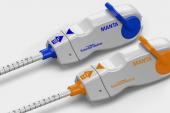More Complications With Plug Closure After TAVI: CHOICE-CLOSURE
The investigator-initiated study highlights the advantages of sutures over the plug-based strategy to close after TAVI.

The results, presented as a late-breaking clinical trial at TCT 2021 and published simultaneously in Circulation, have changed how the researchers do things in their practice.
“We are using suture-based as our default strategy,” lead investigator Mohamed Abdel-Wahab, MD, PhD (Leipzig Heart Center/University of Leipzig, Germany), told TCTMD. “It’s the classic strategy, and we don’t have any evidence now that [the plug-based technique] is better. From an economic aspect, the plug-based strategy is also more expensive in Europe, although we didn’t do a cost-effectiveness analysis. We don’t see any necessity for using it as our primary closure strategy.”
Catheter-based therapies, like TAVI, have evolved over time, but large-bore vascular access has remained a constant, spurring innovators to dream up ways to close access sites swiftly and effectively, without complications. Over time, arterial access-site closure has shifted from direct surgical cutdown to percutaneous “preclosure” with suture-based devices, like the older Prostar XL (Abbott Vascular) and ProGlide. The plug-based closure devices are newer—the Manta collagen plug gained CE Mark approval in Europe in 2016 and US Food and Drug Administration approval in 2019—and now complement the suture-based closure devices.
Mohamad Alkhouli, MD (Mayo Clinic, Rochester, MN), who wasn’t involved in the study, said the collagen plug-based vascular closure device addresses a historical problem when TAVI was performed with earlier-generation devices requiring larger access sheaths.
“It’s a good technology to address a problem of the past,” he told TCTMD. “The analogy I use is that it’s similar with embolic protection devices for TAVR. They were designed when stroke rates were 6% or 7% and it was a major problem. Now we’re down to 1% or 2%. It’s still a problem, but less so than before. The [Manta] device was designed when the sheath sizes were very large and the vascular complication rates were high.”
In addition, as TAVI has shifted into intermediate- and lower-risk patients, patients have healthier arteries, he said. In CHOICE-CLOSURE, the average size of the iliac artery was close to 10 mm. “Patients themselves are lower risk and have healthier vessels,” said Alkhouli. “The TAVR sheaths and delivery systems have improved, and the current collagen-based [plug] systems have not caught up with that progression. They’re trying to solve a problem that was there 5 or 8 years ago.”
Evolution of TAVI
Additionally, if there is still oozing after closure with the suture-based closure device, a smaller plug can be used to provide a more complete seal.
The Manta plug-based device was developed to address some of the early limitations of suture-based closure devices and has previously been shown, in the single-arm SAFE-MANTA trial, to be safe and effective, with a 5.3% rate of major complications at 30 days.
Other findings have been mixed, however. Registry data suggested that the plug-based device was associated with faster hemostasis and a lower rate of vascular complications compared with the suture-based strategy, said Abdel-Wahab, whereas the small MASH study conducted at two experienced European centers showed that use of Manta was associated with a numerically higher rate of vascular complications compared with ProGlide.
CHOICE-CLOSURE randomized 516 patients (mean age 80.5 years; 55.4% men) undergoing TAVI to either the Manta or ProGlide vascular closure devices. Patients were at intermediate risk for surgery and baseline characteristics were well balanced between the two study arms. Symptomatic peripheral artery disease was documented in 7-8% of patients, and the main access-site sheath size was 15-Fr in both groups.
During the index hospitalization, the primary endpoint of access-site or access-related major and minor complications occurred in 19.4% of TAVI patients closed with the collagen plug-based device and 12.0% of those closed primarily with the suture-based ProGlide device (P = 0.029).
Major vascular complications related to the access occurred in 3.9% of those treated with Manta and 1.6% of those treated with ProGlide. Minor access site-related vascular complications occurred in 15.5% and 10.5% of those treated with Manta and ProGlide, respectively. The time to complete hemostasis was 80 seconds with Manta versus 240 seconds with the suture-based device (P < 0.001).
Plug Problems
Abdel-Wahab pointed out that Manta has been around for several years and operators participating in the trial were experienced with its use. In terms of their results, Abdel-Wahab said that while the device-failure rate was similar between the two closure strategies, managing device failures varies.
“It’s quite more complex with Manta,” he said. “With Manta, you don’t have the opportunity if it fails to use another device. It’s all or nothing. It either works or it fails, and if it fails, you need to manage it percutaneously with balloons, stents, or even surgically. We didn’t need surgery in our trial, but we needed stents in the vast majority of patients where the Manta device failed. If you need to intervene, then you have a longer procedure, more bleeding, and so on. If ProGlide fails, you can add additional devices, and you can even switch to Manta as a bailout strategy. You can avoid these complex endovascular interventions and surgery.”
Going forward, Abdel-Wahab said that the suture-based approach is their first choice, but they still have the collagen plug-based device on their shelves in case it’s needed as a bailout strategy when the suture-based strategy fails.
Nicolas Van Mieghem, MD, PhD (Thoraxcenter, Erasmus Medical Center, Rotterdam, the Netherlands), who commented on the study during a morning press conference, also emphasized the importance of experience with large-bore vascular closure devices. Like the smaller MASH trial, where he was the senior investigator, these new data favor the suture-based ProGlide device, although the overall rates of vascular complications were lower in MASH than in CHOICE-CLOSURE. Like Abdel-Wahab, Van Mieghem said that complications with the Manta device do pose problems.
“Bailout maneuvers with Manta, at times, require a covered stent or surgery,” he said. “That’s different than with suture-based closure where you have more percutaneous options.”
Additionally, Abdel-Wahab noted that the rate of pseudoaneurysm was significantly higher with Manta (6.2% vs 1.2%; P = 0.005). It’s possible that the complete and faster rate of hemostasis might have given operators a false sense of security whereby they didn’t provide sufficient manual compression at the access site and this might have led to more subacute localized bleeding.
To TCTMD, Alkhouli said their center performs between 500 to 600 TAVIs annually and they use the suture-based closure strategy. “There are some cases where there is some bleeding and you need a bit more [manual] pressure, but in general, it’s an effective way of handling large-bore access [closure],” said Alkhouli. While the collagen plug-based vascular closure device might not be needed in contemporary TAVI, he said the technology is still relevant and might be used in cases requiring venous access.
“I can see it potentially being used in the future in veins, where we’re doing very large-bore access for a tricuspid valve replacement or mitral valve replacement and venous access is needed,” he said. “Still, I’m not sure a collagen-based [device] will be the right answer—veins are completely different.”
Michael O’Riordan is the Managing Editor for TCTMD. He completed his undergraduate degrees at Queen’s University in Kingston, ON, and…
Read Full BioSources
Abdel-Wahab M, Hartung P, Dumpies O, et al. Comparison of a pure plug-based versus a primary suture-based vascular closure device strategy for transfemoral transcatheter aortic valve replacement: the CHOICE-CLOSURE randomized clinical trial. Circulation 2021;Epub ahead of print.
Disclosures
- Abdel-Wahab reports speaker’s honoraria and/or consultancy fees paid to his hospital from Medtronic and Boston Scientific.
- Alkhouli reports consultant fees/honoraria/speaker’s bureau fees from Boston Scientific and Philips.





Comments